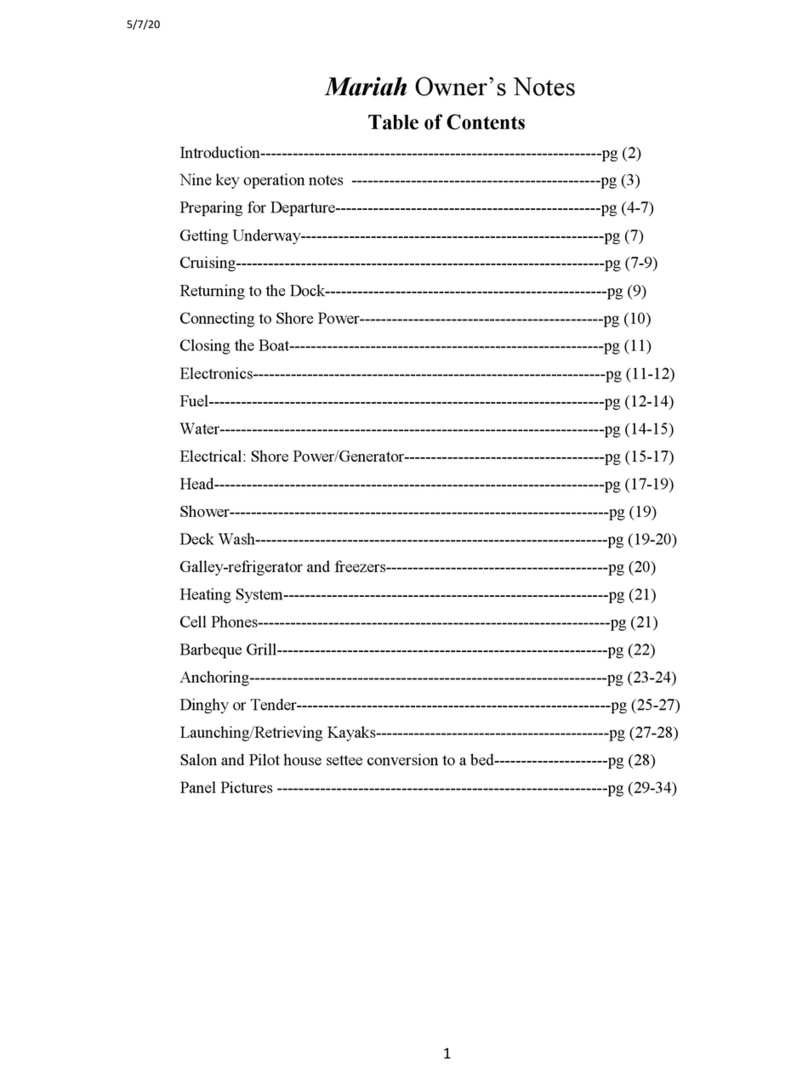
1
Welcome aboard Tivoli!
We searched far and wide for the perfect boat for cruising the Puget Sound, the San Juan Islands and beyond,
and finally found her in Tortola, British Virgin Islands. Tivoli traveled fro the Caribbean to the United States
on her own botto , proving herself as a safe, ocean-going vessel. She is well-designed and well-outfitted for
cruising our local waters.
We purchased Tivoli, because she is configured perfectly for our growing fa ily, which includes two fast-
growing boys, 8 and 11 years old. Here is a quick rundown on why we chose her and why we believe you will
enjoy your ti e aboard as well:
Accommodations: There are three large cabins, each with a queen-sized berth. Each features generous
floor and locker space, nightstands and excellent headroo . There are two heads, including a large
shared head with separate shower off the salon and a private head in the forward stateroo .
Large cockpit: With dual wheels and a large center table, there’s plenty of space for everyone
onboard. The cockpit table has folding leafs, center ice bin with drain for cold drinks, and a ple cup
holders. A custo full-bea swi step and open transo allow easy access and safer dinghy entry.
Speed: Tivoli cruises at 8 knots under power and she sails like a drea .
Smooth and quiet: Tivoli is equipped with an efficient Yan ar diesel and Saildrive, providing quiet,
s ooth otoring when the air is light.
Ease of handling: Two can easily handle her and it’s possible to single-hand in a pinch thanks to
Ger an sheeting (all headsail and ainsail sheets are led aft to the hel s). The ainsail features
lazyjacks and a slippery new Tides track for dropping the sail quickly. Reefing is done fro the cockpit.
Wide uncluttered decks: All lines are led under a cowling between the ast and cockpit, eli inating
trip hazards and providing ore deck space to spread out and enjoy.
Bright and cheerful interior: Light Anigre wood, off-white leatherette upholstery and a ple windows,
both above and below the beltline, create a war living space below with a odern feel.
Excellent tankage: With 150 gallons of water and 50 gallons of fuel, Tivoli can leave the dock behind
and head out on an extended cruise.
100% LE lighting: LE lighting throughout provides bright light and ini al battery drain. Under-
furniture lighting in the ain salon creates a nice a bience when enjoying an evening a glass of wine
or watching a ovie at the end of a long su er day.
By chartering Tivoli for the 2016 season, you will enjoy many new features and e uipment, since she has
just undergone an out-of-the-water, ast-to-keel refit. New equip ent includes all-new Doyle Supercruise
sails, all-new running rigging, all-new Sunbrella canvas with ultra-clear Makralon glass, a new three-zone
diesel hydronic furnace that war s both the air and the floor as well, a new gour et Force 10 galley range
with broiler, all-new galley cookware and serving ware, a new inverter/charger, new house batteries, a new
entertain ent syste featuring a 28” wifi-enabled s art TV and Blu-ray player, a re ote HDMI input at the
navigation table for plugging in a laptop or other device into the TV, a new Pioneer touchscreen stereo with
wireless Bluetooth connectivity that allows you to strea usic or ake a hands-free call to friends and
fa ily fro the nav station, a new high-end ICOM VHF radio with re ote full-feature ic in the cockpit, color
HD radar, DSC and AIS. Tivoli also been fitted with a new Flexofold feathering propeller, which i proves
perfor ance under power and sail. The list goes on, but these are the highlights. Also new this year: We have
equipped our excellent AB alu inu -botto ed dinghy with a new Honda outboard.
Tivoli is new the San Juan Sailing fleet this year. We hope you will enjoy your ti e aboard as uch as we do
and consider Tivoli your ho e away fro ho e while sailing these beautiful waters.
We take great pride in Tivoli’s upkeep. In the interest of keeping her looking great and ensuring that the next
charter guests enjoy her, too, we have so e basic rules we would appreciate you follow. Tivoli is a pet-free,
smoke-free boat.
Listed below are so e tips on how to get the ost out of Tivoli and her equip ent. We sincerely hope you
have a great ti e. If you have questions or feedback before, during or after your charter, we would love to
connect. You can reach us at 206.391.3514.
Fare winds and cal seas,
Cara and Trygve Oye
Legasea LLC




























